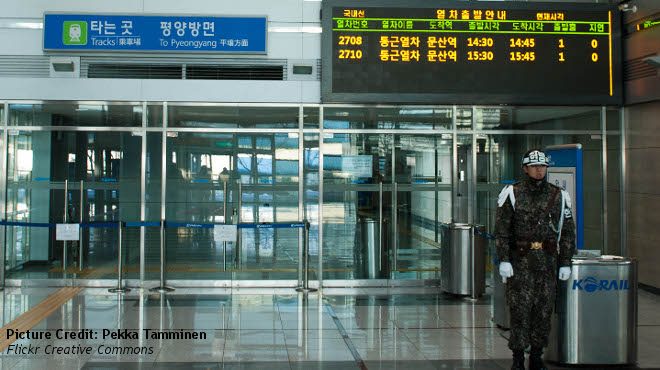The New Mood of Peace in Korea

Alec Forss reflects on his impressions from a recent trip to South Korea on the new mood of peace and the potentials for deepening inter-Korean cooperation.
On a recent trip to South Korea, a friend and former colleague invited me to share in the new optimistic mood of peace in the country. Just months before, the escalation of tensions between North Korea and United States had prompted a real fear of military conflict breaking out.
Since the turn of the year, much has changed as reckless threats have given way to a budding diplomacy. Whereas seven years separated the historic first and second inter-Korean summits in 2000 and 2007, South Korean president Moon Jae-in and North Korean leader Kim Jong Un are anticipated to soon meet for a third time in the space of less than six months.
Underscoring the rationale for the Moon administration’s engagement policy towards North Korea is that a decade of conservative policy under Lee Myung-bak and Park Geun-hye had failed to thwart Pyongyang’s nuclear ambitions. There is thus a recognition that engagement combined with pressure is the only way for incentivizing a change in North Korea’s calculus, even if this will likely be a long and difficult path ahead.
For many in South Korea, furthermore, there is a sense of the need for both Koreas to take things into their hands to bring about lasting peace and stability, rather than be subject to the competing interests of great powers – namely, the U.S. and China.
Reengaging North Korea
Since the diplomatic offensive at the Pyeongchang Winter Olympics that led to the Panmunjeom Declaration in April, inter-Korean cooperation has steadily progressed, albeit has often been overshadowed in the Western media by U.S.-North Korea negotiations and Donald Trump’s Twitter feed.
Talks between North and South Korean militaries have reestablished a hotline and discussed CSBMs to reduce tensions along the DMZ. Later this month will see the first family reunions in three years. Continuing the sports diplomacy, both Koreas will march under a unified flag at the Asian Games which kick off in Indonesia later this week. Dialogue has become the new norm as almost on a daily basis officials from both sides meet at the border village of Panmunjeom to discuss cooperation.
A lynchpin of the Moon government’s efforts is to unlock the economic potential of a peace regime that through its new Northern policy envisages connecting South Korea to the Asian mainland. If successful, North Korea will go from present-day buffer to future bridge – integrated in a region-wide network of transportation, logistical, and energy corridors that will help to spur its economic development and break out of its isolation.
Grand visions aside, there are also a whole host of areas for cooperation. These include providing humanitarian aid, helping to restore North Korea’s depleted forests, disease control and prevention, and joint management of transboundary waters, among many others. With contacts having largely been moribund since 2008, many South Korean ministries, local governments, and other agencies are eager to establish cooperation with their counterparts in the North.
Cautious Optimism
Admittedly, the positive mood of cooperation is not shared by all. Conservative hard-liners and others point to North Korea’s lack of denuclearization and are worried about Trump’s commitment to defend its ally. South Korea’s sluggish economic growth outlook raises question marks over the huge economic resources needed to support the North. Human rights organizations meanwhile are disappointed that human rights have been seemingly relegated on the agenda of inter-Korean dialogue.
Furthermore, after over seventy years of division, the historical cause of unification is not a priority issue for many younger South Koreans, more concerned by employment prospects and the latest trends. The discrimination and difficulties of integration for so-called North Korean defectors – of which there are estimated to be around 30,000 – illustrates that finding social let alone political accommodation will be a huge issue in any unified Korea, even if the prospects of such would today appear far off.
President Moon knows that maintaining enthusiasm and transparency for his engagement policy is crucial. Accordingly, the government has been savvy in mobilizing social media and communicating its strategy to try and build inclusiveness in what is an elite-driven process. So far, despite a recent dip in the polls, Moon’s approval rating remains high.
Looking Ahead
Notwithstanding, the future prospects of inter-Korean cooperation will depend on progress in the U.S.-North Korea track of negotiations. If this should falter, as past history has shown, it will be difficult if not impossible for Moon to sustain engagement. Having played a key role as mediator and facilitator so far, the Moon government will need to do its utmost to encourage momentum as talks between Pyongyang and Washington hit inevitable hurdles.
Linked to this is the significant issue of sanctions on North Korea. Until these are in some way lifted, substantive cooperation will largely remain on paper only. For now, much of the inter-Korean process is being tightly controlled by the Presidential Office and Ministry of Unification, as Seoul plays a delicate balancing act with not appearing to be too far out of lockstep with the United States, upholding sanctions, and maintaining pressure for denuclearization measures.
Close to the DMZ stands Dorasan Railway Station. Rebuilt in 2002 under Kim Dae-jung as part of a project to reconnect the long moribund railway lines between North and South, inside its modern interior carries signs for Pyongyang just over 200 km way. Excepting limited freight traffic, no passengers travelled the route as relations ultimately deteriorated and the so-called sunshine policy faded away.
Standing as both poignant reminder of division but also hopeful symbol of reunion, Moon hopes that he and other South Koreans can complete the legacy of his predecessors and buy a ticket to Pyongyang. Much still needs to be done for that to happen.
Alec Forss is a project coordinator with ISDP’s Korea Center.